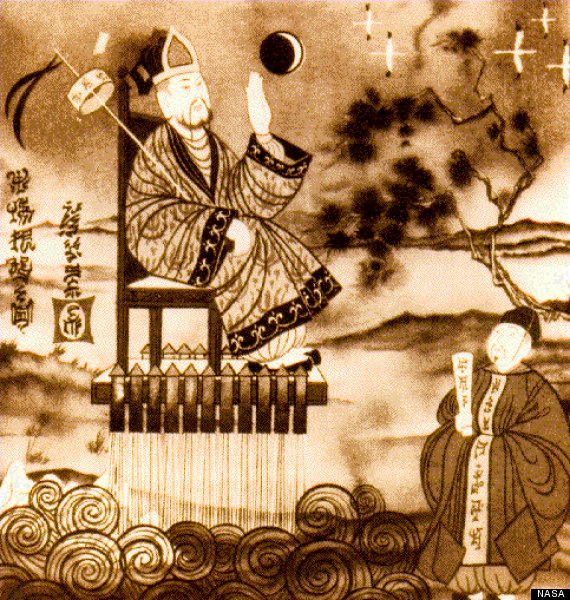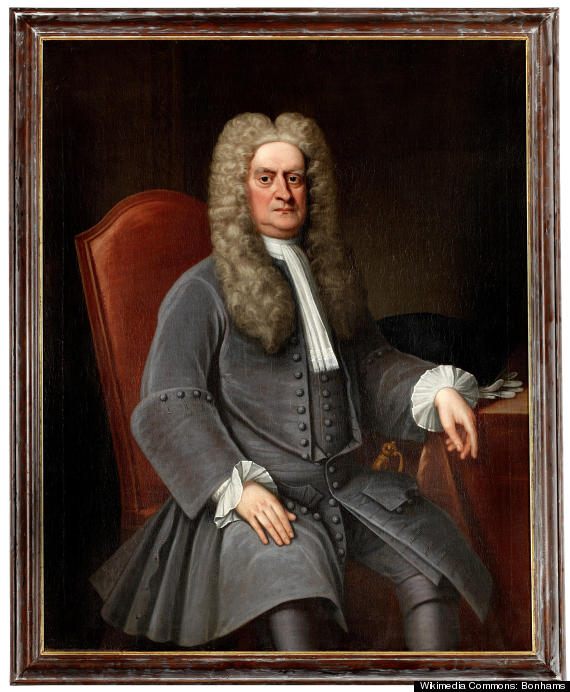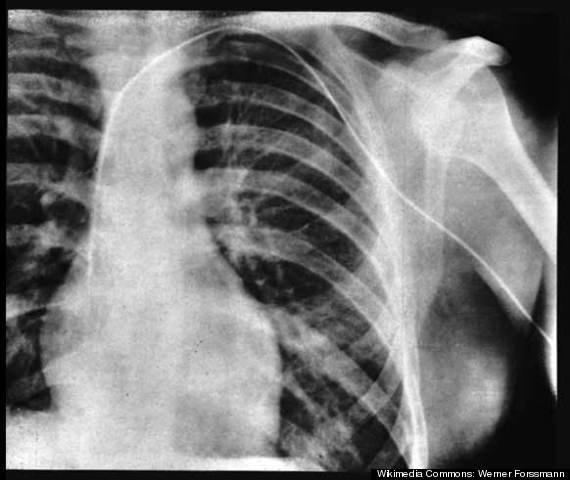What risks would you take in the name of science? Would you keep late hours in the lab, and risk alienating your loved ones? Would you work with toxic chemicals--or deadly pathogens? How about eating glass or riding a rocket sled? How about allowing yourself to be hanged?
If those last three options sound a bit far-fetched, get this: scientists have actually done those and other, even more dangerous things (and not all survived).
Keep reading to learn the incredible stories of the glass-eating, rocket-sled-riding, and getting-hanged scientists -- as well as seven other researchers who risked it all for their experiments.
1. Wan "This Should Work" Hoo tried to ride a rocket chair. You have to hand it to Wan Hoo. Legend has it that when the Chinese official (whose name is sometimes rendered Wan Hu or Wang Hu[1] ) decided to visit the moon, he didn't ask one of his minions to sit in the hot seat. He settled himself into a wicker chair fixed with 47 rockets[2] . When 47 torch-bearing assistants lit the rockets, there was a tremendous sound and lots of smoke--but no more Wan Hoo[3] .
There is, however, a crater named for Wan Hoo[4] on the far side of the moon.

Illustration of Chinese rocketeer Wan Hu.
2. Isaac "Doesn't Bother Me" Newton stuck a needle in his eye. Though best known for formulating the laws of gravitation and co-inventing calculus[5] , Isaac Newton also did pioneering research in optics. He experimented with prisms, but that didn't reveal much about the eye's anatomy or how it perceives color.
To learn more, the quirky physicist took a type of needle known as a bodkin[6] and, he wrote, "put it betwixt my eye & [the] bone as neare to [the] backside of my eye as I could: & pressing my eye [with the] end of it (soe as to make [the] curvature a, bcdef in my eye) there appeared severall white darke & coloured circles..."

Portrait of Isaac Newton painted around 1715.
3. Nicolae "What Are You Looking At" Minovici hanged himself. What better way to learn what it's like to be hanged than to hang yourself? That seems to have been the motivation for Nicolae Minovici, a scientist who worked in Bucharest, Romania[7] during the early days of the 20th Century.
Minovici performed a series of auto-asphyxiation experiments[8] in which he allowed himself to be strangled by ropes. In one, he affixed a hangman's noose to the ceiling, placed his head through the noose, and then had his assistants hoist him up. Though his feet reportedly never left the ground, he experienced a burning pain in his neck and signaled to be lowered. He had trouble swallowing for an entire month.
His research findings on hanging[9] were published in 1904 in Romanian and in 1905 in French under the title "Study on Hanging."

Nicolae Minovici on the job.
4. Franz "Seems Safe To Me" Reichelt tested his parachute by jumping from the Eiffel Tower. On Feb 4, 1912, an Austrian-born tailor named Franz Reichelt tested his "parachute suit"[10] -- an aviator's suit designed to function as a parachute in the event of an emergency.
Alas, the chute failed to deploy, and Reichelt plummeted to his death. The event was recorded in still photos as well as in the grainy video below.
5. Evan "Let Me Handle This" O'Neill Kane took out his own appendix. What does it feel like to undergo surgery? And is general anesthesia really necessary, or is a local anesthetic enough for abdominal surgery? Dr. Kane[11] , a surgeon working in Pennsylvania in the early 20th Century, wanted to find out. So when he needed to have his appendix removed, on Feb. 15, 1921, he opted to perform the surgery himself[12] .
He propped himself up with pillows and set up a mirror in order to get a good look at the incision site. Then, after anesthetizing his abdomen with injections, he started cutting. Thirty minutes later his appendix was out and he was stitched up. The only dicey moment during the procedure came when his intestines popped out of the incision[13] --but he calmly pushed them back in and kept working.

Dr. Evan O'Neill Kane performing self-surgery
6. Werner "Maybe They'll Listen To Me Now" Forssmann stuck a catheter in his own heart. Cardiac catheterization[14] is now a common medical procedure in which a long, thin tube is inserted into the heart via an incision made in the arm, neck, or groin. Of course, it wasn't always so common. In the early part of the last century, it was believed that inserting something into a beating heart would be fatal[15] .
Werner Forssmann thought otherwise. So one day in 1929, the young German surgical resident anesthetized his arm and snaked a catheter up a vein to his heart[16] . To make sure the catheter was where he thought it was, he checked it with an X-ray. He survived the daring experiment but lost his job and was scorned by colleagues. But his fearlessness was rewarded when he won a Nobel Prize[17] in 1956.

X-ray showing catheter (curving white line) in Dr. Werner Forssmann's heart.
7. Frederick "Fill Me Up" Hoelzel ate glass. And not just glass. During the 1920s and 1930s, University of Chicago researcher Frederick Hoelzel reportedly swallowed gravel, glass beads, ball bearings, twine, wire[18] , and other non-food items in order to show how long it would take the items to pass through his intestines. In 1930 his research was published in the American Journal of Physiology under the title "The Rate of Passage of Inert Materials through the Digestive Tract."
Despite his risky research regimen, Hoelzel lived into old age.

Frederick Hoelzel before and after a lengthy fast.
8. Albert "Far Out" Hofman took the first acid trip. LSD was first synthesized in 1938[19] by Swiss chemist Albert Hofman. There was little sustained interest in the molecule until five years later, when Hofman experienced strange sensations after resynthesizing LSD. As he later wrote[20] , he experienced a "not unpleasant intoxicated-like condition, characterized by an extremely stimulated imagination. In a dreamlike state, with eyes closed, I perceived an uninterrupted stream of fantastic pictures, extraordinary shapes with intense, kaleidoscopic play of colours. After some two hours this condition faded away."
Hofman concluded that he had accidentally ingested or breathed in some LSD. On the following Monday, he tested his theory [21] by taking 0.25 mg of the stuff. Sure enough, he experienced similar sensations, including anxiety, visual distortions, symptoms of paralysis, desire to laugh. Unable to continue working, he bicycled home, where he was gripped by anxious feelings--including the fear that he had been dangerously poisoned.
When a doctor's exam reassured him that he had not been poisoned, he began to enjoy himself. As he later wrote: "Little by little I could begin to enjoy the unprecedented colors and plays of shapes that persisted behind my closed eyes. Kaleidoscopic, fantastic images[22] surged in on me, alternating, variegated, opening and then closing themselves in circles and spirals, exploding in colored fountains, rearranging and hybridizing themselves in constant flux."

Albert Hofman in 1993
9. Paul "Who Cares If I Go Blind" Stapp rode a faster-than-a-bullet rocket sled. Now that we've had decades of experience with jet aviation and spaceflight, we have a good sense of the human body's response to powerful G-forces--and how to design the harnesses and ejection seats that keep pilots safe. But there was a great deal of uncertainty until Col. Paul Stapp, an Air Force medical researcher, agreed to subject his own body to incredible G-forces[23] aboard a rocket sled in the California desert.
The possibility that the ride might blind him didn't deter Stapp; in the run-up to the ride, he simply practiced dressing and undressing with the lights out. He went ahead with the ride on Dec. 10, 1954[24] , accelerating from a standstill to a speed of 632 miles an hour in five seconds. Then the sled hit the brakes, stopping completely in 1.4 seconds--and subjecting Stapp to 46.2 times the force of gravity.
Stapp did indeed become blind, though only temporarily. He became famous as the fastest man on earth[25] . Learn more in the video below.
10. Barry "Bottoms Up" Marshall drank bacteria-laden broth. For many years doctors had only a hazy idea about the cause of peptic (stomach) ulcers. Many blamed the condition on psychological stress[26] . But an obscure Australian physician named Barry Marshall was convinced that many ulcers were the result of an infection with a corkscrew-shaped bacterium known as Helicobacter pylori--and that the cure was a course of antibiotics. But there was no simple way for Dr. Marshall to test his theory, as H. pylori affects only primates, and ethical concerns prevented him from using humans. So he decided to be his own guinea pig[27] , taking germs from an infected patient, stirring them in a solution, and drinking it.
A few days later, after experiencing a period of vomiting and exhaustion, he biopsied his own gut--and proved the link between the germs and ulcers. For his daring experiment he won a Nobel Prize in 2005[28] .

Electron micrograph of H. pylori
Also on HuffPost:
References
- ^ whose name is sometimes rendered Wan Hu or Wang Hu (en.wikipedia.org)
- ^ wicker chair fixed with 47 rockets (history.msfc.nasa.gov)
- ^ tremendous sound and lots of smoke--but no more Wan Hoo (www.grc.nasa.gov)
- ^ crater named for Wan Hoo (en.wikipedia.org)
- ^ formulating the laws of gravitation and co-inventing calculus (www.huffingtonpost.com)
- ^ took a type of needle known as a bodkin (www.lib.cam.ac.uk)
- ^ Nicolae Minovici, a scientist who worked in Bucharest, Romania (www.neatorama.com)
- ^ Minovici performed a series of auto-asphyxiation experiments (www.madsciencemuseum.com)
- ^ research findings on hanging (www.minovicifoundation.com)
- ^ Franz Reichelt tested his "parachute suit" (en.wikipedia.org)
- ^ Dr. Kane (en.wikipedia.org)
- ^ perform the surgery himself (www.kanehosp.com)
- ^ when his intestines popped out of the incision (www.madsciencemuseum.com)
- ^ Cardiac catheterization (www.nhlbi.nih.gov)
- ^ inserting something into a beating heart would be fatal (www.ptca.org)
- ^ young German surgical resident anesthetized his arm and snaked a catheter up a vein to his heart (www.nobelprize.org)
- ^ he won a Nobel Prize (www.nobelprize.org)
- ^ Frederick Hoelzel reportedly swallowed gravel, glass beads, ball bearings, twine, wire (www.madsciencemuseum.com)
- ^ LSD was first synthesized in 1938 (en.wikipedia.org)
- ^ he later wrote (www.history.com)
- ^ tested his theory (en.wikiquote.org)
- ^ Kaleidoscopic, fantastic images (en.wikiquote.org)
- ^ Col. Paul Stapp, an Air Force medical researcher, agreed to subject his own body to incredible G-forces (en.wikipedia.org)
- ^ went ahead with the ride on Dec. 10, 1954 (www.nmspacemuseum.org)
- ^ fastest man on earth (www.nytimes.com)
- ^ psychological stress (www.slate.com)
- ^ he decided to be his own guinea pig (discovermagazine.com)
- ^ won a Nobel Prize in 2005 (www.nobelprize.org)
- ^ Send us a tip (www.huffingtonpost.com)
- ^ Send us a photo or video (www.huffingtonpost.com)
- ^ Suggest a correction (www.huffingtonpost.com)

0 comments:
Post a Comment